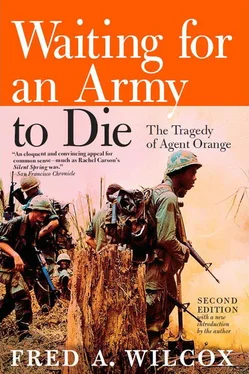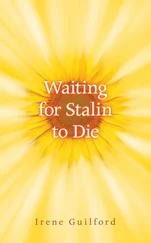Gibson’s observations are substantiated by Australian authors John Dux and P. J. Young, who through careful examination of US General Accounting Office reports, including “grid coordinates and details of all missions flown by C-123s from 1965 to 1968,” found that Phuoc Tuy Province had been heavily sprayed with Agent Orange. Matching the GAO reports with Australian Defense Department maps, the authors concluded: “One can prove conclusively that Australian troops operated in defoliated areas, sometimes within a day of missions.” 2Dux and Young also point out that although the US Ranch Hand operations may have been responsible for the destruction of 12 to 21 percent of the total land in South Vietnam (an area approximately the size of Massachusetts), C-123s spraying was only one source of the toxic herbicides to which Australian and American veterans were exposed. Helicopter pilots, for example, needed only the approval of their unit commander before leaving on a defoliation mission, and it is quite possible that some areas of the province—particularly around base camps—were unofficially sprayed on numerous occasions. Spraying from trucks, riverboats, and by backpack also required only the approval of the unit commander.
Another possible source of contamination was from tanks that were used to spray both pesticides and herbicides directly upon or near base camps. Australian pilots have stated that following herbicide missions, empty spray tanks were refilled with pesticides that were then sprayed directly upon the base camp. Commenting on the possibility that residues from herbicides might have been dispersed in this way, one pilot said: “An interesting thing is that after the spraying missions, which occurred about every month with these aircraft, the rubber trees with which the Task Force area was covered shed their leaves rather alarmingly. After spraying for anti-malarial purposes there would be a sudden increase in skin infections for no particular attributable cause, apart from the fact that it followed the spraying.” 3
When one considers the amount of semi-authorized, unauthorized, and clandestine spraying in Vietnam, as well as wind drift and the fact that an estimated 14 percent of the Agent Orange sent to Vietnam is unaccounted for, it is apparent that the full extent of the defoliation campaign may never be known. What is clear is that Vietnam veterans whose units are not listed by the Department of Defense or General Accounting Office as having been in spray zones could very well have been exposed to toxic chemicals either in and around their base camps or on ambushes and search-and-destroy missions in the surrounding jungle.
When his son Cameron was born with a “noncorrectable” birth defect, Jim Wares wanted to know why. But doctors were unable to give him a satisfactory explanation, and he decided not to dwell on the boy’s misfortune. After all, Wares told himself, he had survived Vietnam, was married to a fine woman, had a good job, and the boy, except for missing fingers, was beautifully formed, an optimistic and intelligent child whom Wares says is fond of making up stories and playing practical jokes with his hand. One evening, for example, Wares and his wife left their son with a babysitter who, summoned to the bathroom by the boy’s cries, discovered him standing near the toilet bowl. Feigning distress and holding out his hand with the missing fingers, the boy announced that he had accidentally “flushed the fingers away.” The babysitter, says Wares, didn’t know whether to laugh or cry.
Wares had heard stories about Agent Orange and wondered if it might have something to do to with Cameron’s deformity, but the government’s official position was that Orange had not been used in Nui Dat. Besides, argued government officials, scientists had found “no link” between exposure to herbicides and human health problems. But the Australian news media were becoming increasingly interested in the veterans’ problems, and after reading an interview with a veteran whose eyesight was failing and who was suffering from constant trembling, diarrhea, fatigue, and vomiting, Wares decided to begin his own research into the matter. Calling people whose names had appeared in news articles, Wares was amazed to discover that each person he contacted knew other veterans who were sick, whose wives had suffered miscarriages, or whose children were deformed. Wares soon realized that something was seriously, perhaps disastrously, wrong with his fellow Vietnam veterans.
Wares began listing on filing cards the symptoms of veterans with whom he had spoken or corresponded by mail. Sorting through a stack of fifty cards one afternoon, he discovered that nearly one in four of the men he had contacted had fathered a deformed child. Four of the cards actually listed children born with deformed hands, and three out of the four were born with four fingers and half the thumb missing from one hand. On other cards Wares had listed cases of deformed legs, clubfeet, deafness, and missing ears. With each passing day Wares found himself increasingly involved in trying to sort out the truth about his own and his fellow veterans’ exposure to toxic chemicals. With each rebuff from the government his anger—and the veterans’ movement in Australia—grew. The country’s enormous size and the scarcity of money sometimes made logistics rather difficult; but like their counterparts in the States, Australian Vietnam veterans drew support from the realization that they had at least three things in common: they had served in an area of Southeast Asia that had been heavily sprayed with defoliants; many of them were sick, dying, or had fathered children with birth defects; government officials, while expressing concern, were doing little to resolve the issues in a fair and compassionate manner.
“When we first got involved with the movement in Australia,” Wares explains, “I went to the Royal Alexandria Hospital for Children in Sydney, saw the chief pediatrician, and asked some questions. I said, ‘My son has been born with no fingers on one hand.’ And I asked if he had any statistics on that kind of deformity. Now, in Australia most of the hospitals don’t keep that kind of statistics. There’s no national statistics on birth deformities. Some hospitals keep them, some don’t; it’s very ad hoc. So I told this guy that my son was born with no fingers, ‘but his arm isn’t withered, it’s not short, there’s just no fingers. It’s only affected one limb, which in itself I understand is rather unusual.’ And I said, ‘What are the chances of this happening?’ And he said, ‘Well, I would say that using statistics, one in fifty thousand is way over the odds.’
“So I told him, ‘What would you say if I told you that I know another two kids with exactly this same deformity? Exactly the same.’ And he said, ‘My God, that’s incredible.’ And I said, ‘Well, if I told you that both their fathers were Vietnam veterans, and there were only forty-five thousand men from this country who went to Vietnam, and of the three children I know with this deformity all of their fathers are veterans, how would that affect you?’ He was absolutely staggered. To such an extent that he said, ‘What we will do is we’ll test all of the veterans’ children who are deformed free of charge at this hospital.’ And that was in the Sydney press, and in the Australian national press. But one week later that decision was reversed. Politics. The hospital board decided it wouldn’t be done!”
Wares, Holt McMinn, and John Harper eventually formed the Vietnam Veterans Action Association. McMinn had served in Vietnam with an elite commando unit, the Special Air Service Regiment; but after several months in the bush he began coughing blood, his hands were covered with rashes, and, diagnosing his condition as bronchial asthma, Army doctors sent him back to Australia. McMinn attempted to return to Vietnam in 1968, but after examining his health records the Army refused to grant his request. His health continued to deteriorate and he was forced to enter a repatriation hospital where, after three months of tests, doctors told him they could find no reason for his hemorrhaging. His problem, they said, was obviously psychological. Discharged from the military and given a 20 percent disability pension, McMinn was accused by an examining doctor of being a “malingerer” who was trying to “rip off the government.”
Читать дальше











